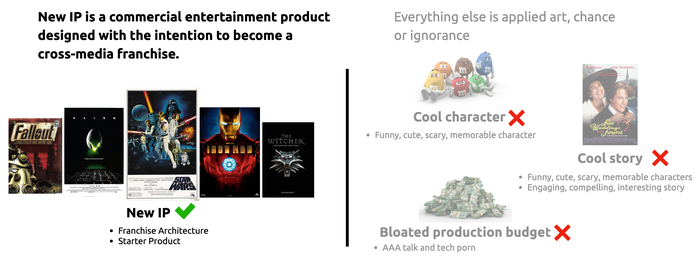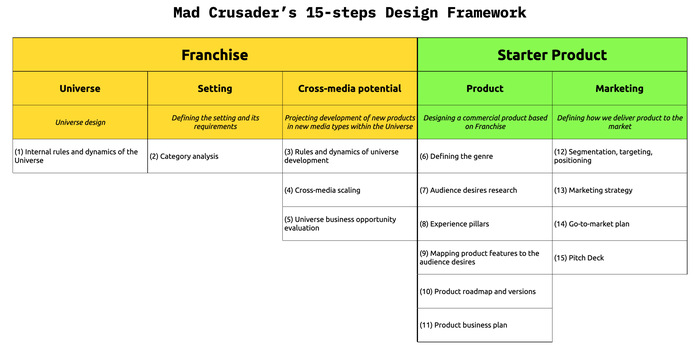Trending
Opinion: How will Project 2025 impact game developers?
The Heritage Foundation's manifesto for the possible next administration could do great harm to many, including large portions of the game development community.
A guide on developing intellectual property (IP) for cross-media franchises in the GameDev industry.

I’m writing this for those creative visionaries who want to see their ideas gain mass adoption while they’re still alive. I’m dead serious. Games are a form of art—and, in my opinion, one of the most impactful. But if your goal is to create timeless, undying art for future generations to discover, skip this article.
The AI era is here. While doomsday scenarios and tech singularity make for interesting conversations, the real story is how AI is changing the way we create content—just like the Industrial Revolution did for manufacturing. Content is now cheaper, faster, and easier to produce.

In this landscape, you have two choices:
Try to produce pixels faster and cheaper than robots.
Become someone who defines what pixels need to be produced, and most importantly, why.
The global entertainment industry is entering a phase where, to maintain at least some control, you must own a cross-media franchise—a fictional universe that can be adapted into commercial entertainment products across multiple media types.
Only 0.1% of companies own cross-media franchises. Another 0.1% can buy them. The remaining 99.8% will have to figure out how to create New IPs with cross-media franchise potential.
Investing in New IP is risky, yes. But the concept of “New IP” itself is often unclear. As a result, we don’t invest in it often enough for patterns to emerge, and when we do, we’re doing it wrong.
IP stands for Intellectual Property, meaning your tweet, a poem for a loved one, a fantasy book series, a photo, sports performance stats, a video game, a brand mascot, or even a drilling rig design—all fall under this category. However, in the video game and narrative-driven entertainment industries, we often give IP a very specific meaning. Yet, when asked, even industry experts may fumble, mentioning a brand, a cool story, or a bloated production budget with uncertainty. So let me put it straight for you: New IP is a commercial entertainment product designed with the intention to become a cross-media franchise. And that’s what we’ll be talking about here.
It’s a monumental task to pull off something like a New IP. You and your team will learn a lot and transform along the way. There’s no playbook, but let’s look at the key do’s and don’ts to help navigate your New IP development journey.

1. In the very beginning, ask yourself what you’ll do if this IP is a success. When you develop a new game, you have the odds stacked against you. About 80% of games don’t make it to release. About 19 out of 20 that do release fail or underperform for various reasons. You’ll have to figure that out, but don’t lose sight of the bigger picture. The question that will get you in the right mindset is, what if you succeed? Let me give you an example. You all know the game Journey—a beautiful, iconic indie project that sold millions of copies on multiple platforms. But then what? As a visual commercial entertainment product and as an IP, it’s nothing more than two black triangles over a yellow background. You can’t make a movie or TV series out of that; no comics, books, action figures, or even stickers for messengers. So, don’t find yourself in a situation where all the odds played in your favor, but now you're left with one option: get your act together and make another game—with all the risks associated with it. To avoid that, you need an IP-first mindset. The easiest way to achieve this is to ask yourself from the very beginning: What will I do with it if it succeeds?

2. Franchise architecture before picking a setting. Before you start writing lore and going deep into characters, locations, and artifacts, and even before you pick a setting, you need to clearly define the franchise architecture. You need to design the amusement park layout before you pick a theme and start building attractions. If I asked you what the Game of Thrones franchise architecture is, you might say fantasy, dark fantasy, political strategy, episodic structure, or even zombie apocalypse—but those are just the surface. George R.R. Martin used archetypal individual traits like courage, greed, lust, and intellect and applied several modifications to each. For example, courage could be justice-seeking (Starks), bloodthirsty recklessness (Dothraki), or personal gain (Bronn). He then turned these traits into factions represented by characters, creating a system that works like a kaleidoscope: for every instance (scene, chapter, episode, season, storyline), you pick 3-5 of these characters/factions and see how their traits play out. He also applied a constant pressure on the system, called a "main conflict"—for GoT, it was the ancient threat of extinction. This pressure created a perfect "content treadmill." The setting here helps unlock the system’s potential. If you understand franchise architecture, you’ll know exactly what went wrong with Season 8 of the TV adaptation. So start with franchise architecture:
Unit of action: In GoT, this would be character traits. You could use archetypes, species, political systems, galaxies, etc.
Rules of interaction: In GoT, this would be character motivations and capabilities. Define what’s possible in your world.
Pressure: In GoT, it was a global existential threat. Use the highest-stakes conflict or paradox that cannot be ever resolved.
Experiment with these components. You’ll notice you don’t even need a setting at this stage.

3. The setting is the reason why people will come. When building a New IP, the setting is a strategic choice that helps you unlock your franchise architecture. Some systems work best in realism, others in fantasy, alternative history, or the distant future. The goal is to make your world believable and avoid unconscious disbelief. Hundreds of fantasy blockbusters have taught audiences that dragons are real, while sci-fi has trained them to accept teleportation and time travel. The setting also defines who will be attracted to your IP and what they will expect. If you think, "Everyone uses elves in fantasy, but I’m special so I won’t," read the first paragraph and think again.
The most lucrative segment for cross-media franchises is Geeks. They have literally funded the success of 100 titles from IMDb’s Top 250, 194 of the top 250 Metacritic games, and 138 of the top 200 box office titles. Twelve high-demand settings resonate with this audience: Fantasy, Dark Fantasy, Sci-Fi & Multiverse, Cyberpunk, Heroic Adventure, Urban Legend, Post-Apocalypse, Noir/Dark Detective, Action Blockbuster, Myth-Legend-History, Alternative History, and Anti-Utopia & Social Satire. Pick one, but remember that by doing so, you’ll attract people educated by hundreds of successful titles in that setting. They have a mental bookshelf with the setting’s name, packed with the best examples. Your task is to embed what they love most and add innovation on top.
4. Experience is the reason why people will stay. To get your IP to the market, you need a product. In this case, a game. But before thinking about features or your favorite genre, consider your audience. Look at your franchise architecture and chosen setting, and ask: What’s the best way for people to experience what I’ve envisioned? What do you want them to do and feel? Answering these questions will make choosing a genre a conscious decision and may even inspire meaningful innovation.
5. 1-800-WHO-CARES. In 2015, Justin Guarini’s viral tweet said: “Starlord: Galaxy. Superman: Earth. Spiderman: NYC. And then there's Daredevil micromanaging the shit out of 10 blocks in midtown Manhattan.” (https://x.com/JustinGuarini/status/624423465420988416). The point is, the scale of your world and the problems it addresses are key predictors of adoption and commercial potential. Think of the difference between Lord of the Rings and A Wizard of Earthsea. Both have much in common, but LotR focuses on a larger-than-life struggle between good and evil, while Earthsea is a personal psychological journey. Saving the universe from an evil overlord will always outshine overcoming childhood trauma in Boring, Oregon.
Read more about:
BlogsYou May Also Like